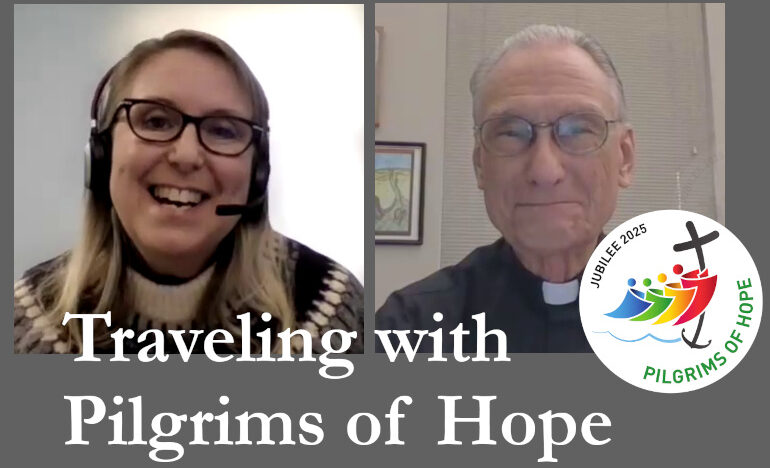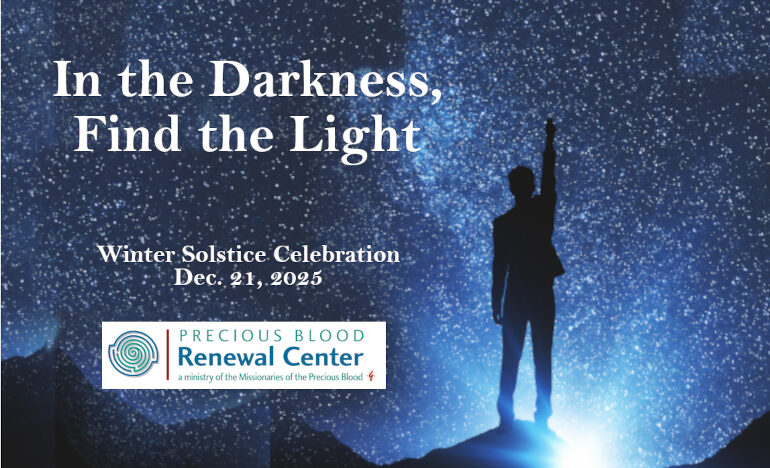Video Series: Breath as a Threshold to the Present Moment

By Kathy Keary
Our full series on Contemplative Life is here.
At the Renewal Center, we recently began studying the book Sacred Time: Embracing an Intentional Way of Life by Christine Valters Paintner, a Benedictine Oblate. It’s packed full of spiritual practices, some of which I will include in our Contemplative Life series.
Today we will focus on our breath. Paintner states: “The breath is a threshold – a gateway to a profound immersion in this moment here and now. When we cultivate the ability to allow our breath to anchor us, our awareness can become deeply rooted in the present. The past has come to completion. The future is yet to be created. And while both remembering and dreaming are vital acts, when they move into regret and anxiety, we are drained of the life offered to us right now.”
Focusing on our breath is an invitation to the present moment. A contemporary spiritual teacher, Eckhart Tolle, points out in his book, Power of Now: A Guide to Spiritual Enlightenment, that the wisdom of the present moment is addressed in the Gospels when it instructs, “Do not worry about tomorrow; tomorrow will take care of itself,” or “Nobody who puts his hands to the plow and looks back is fit for the Kingdom of God.” There is also the familiar passage about the lovely flowers that do not fret about tomorrow but “live with ease in the timeless Now and are provided for abundantly by God.”
The great Sufi poet, Rumi, proclaims: “Past and future veil God from our sight: burn up both of them with fire.” Meister Eckhart, the thirteenth century German mystic declared: “Time is what keeps the light from reaching us. There is no greater obstacle to God than time.”
I frequently return to a focus on my breath when I am meditating recognizing that my monkey mind has taken over. I discovered years ago that distractions are non-existent when I focus on my breath. Give it a try. Focus on your breath as you inhale and exhale fives times.
Did you notice that you remained in the present when you focused on your breath? You may have also noticed that it is quite calming.
Paintner points out the four parts of breathing. Inhalation and then a pause before we exhale which is followed by another pause before we inhale again. She suggests a four-part prayer of gratitude to accompany our breathing:
- When we inhale, we recall that God graced us with the gift of life.
- We then pause filled with gratitude and the Spirit of God who is within us.
- With gratitude we exhale, mindful to share this gift freely given to us with others.
- We then pause resting in emptiness.
I will walk you through this breathing prayer twice and then invite you to do it on your own three more times.
- Inhale – God graced us with the gift of life
- Pause – Filled with gratitude and the Spirit of God
- Exhale – We share this gift with others
- Pause – rest in emptiness
Paintner speaks of the threshold moments in our life when we switch from one activity to another. This space of transition or threshold, Painter explains, is a “sacred dimension, a holy pause full of possibility.” She suggests that we develop a practice of sitting in silence for 5 minutes or take 5 long, slow, deep breaths during these threshold moments. I invite you to do this right now before we transition to our next breathing exercise. Take 5 long, slow, deep breaths.
As you implement a breathing practice, note how it affects you physically, mentally, emotionally, and spiritually. I find it has a calming effect. I feel a sense of interior spaciousness and feel connected with the Divine that dwells within me. It definitely brings me to the present moment.
Now we will connect our breathing with imagining the seasons of the year. As you inhale, visualize the blossoming of spring. Pause as you visualize the fruitfulness of summer. As you exhale, visualize the release of Autumn. As you pause again, visualize the resting of winter. Try this five times.
A practice I find soothing is to reflect on a sacred passage as I breathe in and out. The one that I frequently use is “Come, Lord Jesus. Fill me with your presence.” So as I inhale I say to myself, “Come Lord Jesus.” In the pause, I rest in the comfort that God is with me. When I exhale, I say to myself, “Fill me with your presence.” On the pause I sense God’s presence within me.
The passage you use can be from any source or words you create. You might choose words from a song, a poem, or Scripture. Examples are:
- “Come to me, and I will give your rest.”
- “Be still and know that I am God.”
- “Trust in the Lord with all your heart.”
- “All you who are thirsty, come to the water.”
- “Come, Lord Jesus. Fill me with our presence.”
I invite you to give this a try right now by picking words that speak to your heart and incorporate them into the breath prayer. Do this five times.
In the early church, monks developed breath prayers like these to help them abide by St. Paul’s summons to “pray without ceasing.”
I hope you try a breathing practice that resonates with you. I think you will find that it is quite fruitful.
Thanks for joining us today. I will return next week as we continue our series on contemplative prayer.
You can sign up for our weekly newsletter below so you will not miss any reflections or videos that the Renewal Center publishes.
May you feel the loving embrace of our God!
Note: Never miss an article published on the Renewal Center website: Sign up to receive our newsletters.
[Kathy Keary, spiritual director, holds a bachelor’s degree in education, a master’s degree in theological studies, and completed Sophia Center’s Souljourners Program, an intense study of spirituality and spiritual direction. Kathy believes that the Divine is present and active in all of life and encourages others to be awakened to the God in all including the Divine within. She enjoys accompanying others on their journey to wholeness discovering the person they were created to be.]
“Breathe” by wanderlust octopus is licensed under CC BY-NC-SA 2.0
Related

Pilgrims of Hope, Episode 11 Walking with Young People
In this episode of the Jubilee Year video series, “Traveling with Pilgrims of Hope,” we talk with Teri Iverson, the Vocation Ministry Coordinator for the Sisters of the Precious Blood in Dayton, Ohio, about the joy and hope she finds in working among young people.

Video: Winter Solstice Celebration 2025
The Winter Solstice is the longest night of the year and the earth lies fallow. We are drawn naturally into contemplation. At the Renewal Center, we mark the Winter Solstice with a time of slow, quiet reflection and fellowship.
Categories
Assembling God's Puzzle Coffee with Padre Cooking & Spirituality Encounters of the 4th Kind Family Matters Guided Meditations Reflections on the Eucharsitic Prayers Spiritual Resources Taize Prayers Teach Us to Pray The Contemplative Life Traveling with Pilgrims of Hope Uncategorized Videos When you need a little help
